|
|
|
Sort Order |
|
|
|
Items / Page
|
|
|
|
|
|
|
| Srl | Item |
| 1 |
ID:
184191


|
|
|
|
|
| Summary/Abstract |
How do disasters affect intergroup peace and conflict? Existing research shows that disasters can have opposing effects on how we perceive others: they can exacerbate existing tension in some cases or serve as catalysts for peace and cooperation in others. Yet we know little about the conditions under which we should expect one or the other. In this study, we estimate the impact of disasters on perceptions of out-groups. We combine a dataset of mass disasters with tens of thousands of individual-level survey responses recorded in Round 6 of the Afrobarometer data between 2014 and 2015. Using a difference-in-differences approach exploiting spatial and temporal proximity to disaster occurrences, we estimate the degree to which disasters affect public opinion toward out-groups. As disaster occurrence is plausibly exogenous to interview dates or respondent locations, our approach allows for an improved test of how the shock from disaster can impact public perceptions. Moreover, we show such impact varies by considering the differences in political salience of out-group identities and short- versus long-term differences in the impact on group dynamics. The implications of our findings for understanding the aftermath of past disasters and effects of future disasters on intergroup peace and conflict are discussed.
|
|
|
|
|
|
|
|
|
|
|
|
|
|
|
|
| 2 |
ID:
102513


|
|
|
|
|
| Publication |
2011.
|
| Summary/Abstract |
In the past few decades, planned contact interventions between groups in conflict have played an important role in attempts at improving intergroup relations and achieving peace and reconciliation. This article focuses on such reconciliation-aimed intergroup encounters between Israeli Jews and Palestinians that seek to reduce hostility and increase understanding and cooperation between the two nationalities. Like other contact interventions conducted in settings of intergroup conflict, encounters between Israeli Jews and Palestinians represent a paradoxical project: this is a project that aspires to generate equality and cooperation between groups that are embedded in a protracted asymmetrical conflict. Though existing research teaches us valuable lessons on the effectiveness of contact conducted under optimal conditions, little is said about contact between groups involved in asymmetrical protracted dispute. The goal of this analysis is to examine the evolution of reconciliation-aimed contact interventions between Israeli Jews and Palestinians in the past 20 years. The research method is qualitative, relying on ethnographic data assembled during the relevant period of time. The findings identify and trace the evolution of four major models of Jewish-Palestinian planned encounters: the Coexistence Model, the Joint Projects Model, the Confrontational Model, and the Narrative-Story-Telling Model. The strengths and limitations of each model in transforming intergroup attitudes in asymmetric conflict are discussed.
|
|
|
|
|
|
|
|
|
|
|
|
|
|
|
|
| 3 |
ID:
122521
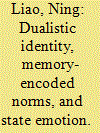

|
|
|
|
|
| Publication |
2013.
|
| Summary/Abstract |
By tracing the origin and evolution of Chinese nationalism, this paper finds that the dialectical relationship between the Chinese "self" and the foreign "other" has provided the cultural-institutional context for the construction of its national identity. The positional change of the Chinese actor in the self-other interaction-resulting from the institutional shift from the tianxia order to the Westphalian system-and the consequent national humiliation have been embedded in the Chinese collective memory and given rise to the consensual norms ingrained in the national identity. Viewed through the lens of political sociology and identity politics, China's tenacious struggle for national rejuvenation can be construed as a social practice guided by these memory-encoded social norms. Due to the protracted and ambivalent nature of the state's purposive action in attaining great-power status on the international stage, the confidence of the resurgent state is compromised by an acute sense of frustration. This identity predicament has engendered a peculiar Chinese state emotion, which has profoundly influenced the in-group members' evaluation and perception of out-group entities and their behavior in the antagonistic intergroup relations.
|
|
|
|
|
|
|
|
|
|
|
|
|
|
|
|
| 4 |
ID:
065051


|
|
|
|
|
| Publication |
London, Routledge, 2005.
|
| Description |
xii, 144p.
|
| Series |
Contemporary Security Studies
|
| Standard Number |
0415365872
|
|
|
|
|
|
|
|
|
|
|
|
Copies: C:1/I:0,R:0,Q:0
Circulation
| Accession# | Call# | Current Location | Status | Policy | Location |
| 049973 | 303.62089/SOE 049973 | Main | On Shelf | General | |
|
|
|
|
| 5 |
ID:
065343
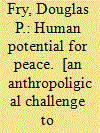

|
|
|
|
|
| Publication |
New York, Oxford University Press, 2006.
|
| Description |
xvii, 366p.
|
| Standard Number |
0195181786
|
|
|
|
|
|
|
|
|
|
|
|
Copies: C:1/I:0,R:0,Q:0
Circulation
| Accession# | Call# | Current Location | Status | Policy | Location |
| 050062 | 303.6/FRY 050062 | Main | On Shelf | General | |
|
|
|
|
| 6 |
ID:
104561


|
|
|
| 7 |
ID:
192903
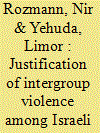

|
|
|
|
|
| Summary/Abstract |
This article investigated whether perceived threat is related to justifying intergroup violence based on integrated threat theory. Israeli-Jewish participants (n = 236) answered questions on perceived Israeli-Arab threat, frustration leading to aggression, and intergroup violence justification. The findings indicate that there is a significant correlation between perceived realistic threat and intergroup violence justification, whereas no significant correlation was found between frustration leading to aggression and intergroup violence justification. These results suggest the need to better understand intergroup conflicts in the field of international relations.
|
|
|
|
|
|
|
|
|
|
|
|
|
|
|
|
| 8 |
ID:
186732
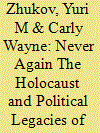

|
|
|
|
|
| Summary/Abstract |
Do individuals previously targeted by genocide become more supportive of other victimized groups? How are these political lessons internalized and passed down across generations? To answer these questions, the authors leverage original survey data collected among Holocaust survivors in the United States and their descendants, Jews with no immediate family connection to the Holocaust, and non-Jewish Americans. They find that historical victimization is associated with increased support for vulnerable out-groups, generating stable political attitudes that endure across generations. Holocaust survivors are most supportive of aiding refugees, followed by descendants, especially those who grew up discussing the Holocaust with their survivor relatives. An embedded experiment demonstrates the steadfastness of these attitudes: unlike non-Jews or Jews without survivor relatives, survivors’ and descendants’ views toward refugees do not change after reading an in-group versus out-group–protective interpretation of the “never again” imperative. Histories of victimization can play an ameliorative role in intergroup relations.
|
|
|
|
|
|
|
|
|
|
|
|
|
|
|
|
| 9 |
ID:
190882
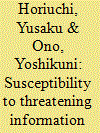

|
|
|
|
|
| Summary/Abstract |
A growing number of news articles and politicians’ statements treat refugees as potential terrorists. However, existing research has yet to thoroughly examine how threatening information about refugees affects natives’ attitudes toward refugee resettlement. To address this issue, we conducted a survey experiment in Japan, where the number of refugees accepted each year is extremely small, despite the rapid increase in news about refugees. Our results show that opposition to refugee resettlement is associated with its proximity. Specifically, we find two types of NIMBY (not-in-my-backyard) attitudes – within-country and between-country NIMBY-ism – toward refugee resettlement among Japanese people. Additionally, respondents become more strongly opposed to refugee resettlement when exposed to threatening frames that depict refugees as harmful, regardless of the proximity to threats and potential resettlement. These findings add nuance to the scholarly literature on threat perceptions and public attitudes in intergroup relations. First, our findings suggest that NIMBY attitudes toward refugee resettlement (shown in Ferwerda, Flynn & Horiuchi, 2017) are not a US-only phenomenon. Second, we provide empirical evidence to support the theory that subjectively perceived threats affect people’s hostility toward out-group members, even in the absence of actual threats. Finally, we contribute to the recent debate on the effects of proximity to threats. Our results support the argument that the psychological effects of terrorism on negative attitudes toward immigrants and refugees are more pronounced in homogeneous societies, irrespective of proximity to the threat.
|
|
|
|
|
|
|
|
|
|
|
|
|
|
|
|
| 10 |
ID:
191841


|
|
|
|
|
| Summary/Abstract |
Culture is a central concept in the social sciences. It is also difficult to examine rigorously. I study the oldest university in East Africa and a cradle of political elites, Makerere University, where halls of residence developed distinct cultures in the 1970s such that some hall cultures are activist (e.g. Lumumba Hall) while others are respectful to authorities (e.g. Livingstone Hall) even though assignment to halls has been random since 1970. I leverage this unique setting to understand how culture forms and affects the values and behaviours of young adults. Participant observation, interviews and archives suggest that cultural differences arose from critical junctures that biased group (hall) composition and from intergroup (inter-hall) competition. Hall governments promote cultural and institutional persistence through the intergenerational transmission of norms and practices, thereby highlighting the role of political hierarchy in reproducing culture.
|
|
|
|
|
|
|
|
|
|
|
|
|
|
|
|
|
|
|
|
|